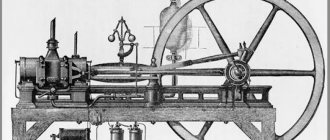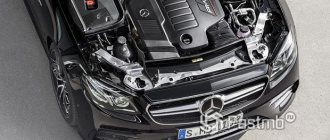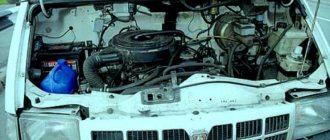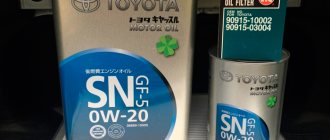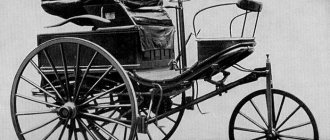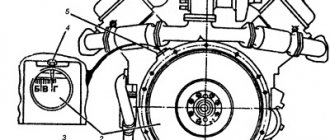Content
- Renault Logan II
- Renault Duster I (before restyling)
- Hyundai Solaris I
- Volkswagen Polo V (before restyling)
- Toyota Corolla X (E140, E150)
When choosing a used car, many buyers look at its efficiency: so that the car consumes little fuel and is inexpensive to maintain and maintain. Taking these parameters as a basis, avtocod.ru found out which aftermarket cars are the most economical, and compiled the top 5 cars that will not ruin the owner’s wallet.
Renault Logan II
- Secondary prices: 350-600 thousand rubles
- Engines: 1.6 l (8 cl., 84-87 hp); 1.6 l (16 cl., 102-105 hp); 1.6 l (113-114 hp)
- Transmissions: Manual transmission-5, automatic transmission-4, variator
Renault Logan is the most economical car in our opinion: inexpensive, technically simple and unpretentious. The version with a manual transmission is considered the most economical: the gearbox here is eternal. The only thing that can disappoint is the not very clear gear selection, but you quickly get used to it.
Paired with this gearbox is a 1.6 liter engine producing 87 hp. s., which consumes only 5.5-7.0 liters of fuel. It does not shine with dynamics, but a resource of 300-500 thousand km will please anyone. More powerful brother with 102 hp. With. will allow you to “play around” in tandem with a manual transmission: 10.5 sec. up to 100 km/h and average consumption around 6 liters!
Motors happily consume both AI-92 and AI-95. Among the shortcomings are crankshaft oil seal leakage and valve cover fogging. Treated by replacement. The parts are cheap, but the work costs around 6,000-7,000 rubles. “Oil burn” is not observed even for runs under 200 thousand km.
The suspensions are omnivorous and cope well with Russian roads, but at mileage of 30-70 thousand km the ball joints of the front suspension arms may require replacement. If you load the car to full capacity, by 120 thousand km the shock absorbers and springs may get tired. Replacing it around will cost inexpensively - 13-18 thousand rubles. There are no other problems with the car.
In addition to being economical, Logan will also delight you with its high ground clearance (155 mm) and huge trunk (510 l).
Over the past 30 days, Renault Logan was struck 17,355 times through the avtocod.ru service. 83% of the vehicles tested were involved in an accident. Every second car was sold after a taxi, every third - with unpaid fines or repair costs.
Every sixth Logan had traffic police restrictions or increased mileage. There were also cars that were leased, pledged, and with a duplicate title. Only every tenth Renault Logan II had no problems.
Also read: Sequel to the bestseller: review of Renault Logan II
The most economical engine in the world in a car
To accurately answer which is the most economical car in the world and with which engine, you need to pay attention to the ratings of the TOP 10 most economical cars.
Today, the Germans from Volkswagen have advanced the furthest in this direction, introducing the XL1 model. The specified Volkswagen XL1 was officially recognized as the most economical car in the world.
We also recommend reading the article about which internal combustion engines are considered the best engines in the world. From this article you will learn about power plants, which, according to experts and authoritative publications, are in the TOP 10 best engines on the planet.
The car appeared in 2013, the main emphasis was on environmental friendliness and super-efficiency. When driving on the highway, the model consumes a little less than 1 liter per 100 km. The engine is a hybrid, a combination of an economical diesel engine and an electric motor.
Also among the concepts and developments in the field of the most economical cars, one can highlight the unique Alerion Supermileage car, although such a car can be considered more of a project, which is still very far from production versions.
Renault Duster I (before restyling)
- Secondary prices: 490-780 thousand rubles
- Engines: petrol 1.6 l (102 hp); 2.0 l (135 hp), diesel 1.5 l (90 hp)
- Transmissions: Manual transmission-5, Manual transmission-6, Automatic transmission-4
Renault Duster is designed specifically for economical drivers. With a 1.6 engine with a manual transmission and front-wheel drive, it consumes up to 10 liters of fuel in any mode. Ground clearance of 205 mm and a large trunk volume of 475 liters (1636 liters when unfolded) will be appreciated by lovers of outdoor activities. The disadvantages of the 1.6-liter engine are lack of power and rather weak dynamics (11.5 seconds to 100 km).
If you take a Duster with a 2.0 liter petrol engine and all-wheel drive, you will get a noble “rogue” with a ground clearance of 210 mm. For mushroom pickers and fishermen - just the thing! The multi-link rear suspension allows for good handling and gives confidence on the road. The two-liter engine is paired with a six-speed manual or four-speed automatic.
For travelers, the diesel version with a 1.5 liter engine with a manual transmission is suitable. Although it does not shine with dynamics (15.6 seconds to 100 km/h), it is very economical in consumption - only 5-6 liters.
Fogging headlights (cannot be treated), weak paintwork (touch up or repaint), steering tips and ball joints that “give up” after 60-70 thousand km can cause trouble for the owner of the Duster. For off-road enthusiasts, electrics can bring “surprises”: the contacts of the rear lights may oxidize, the automatic transmission wiring may “switch off,” or the sound signal may disappear.
But the archaic nature of the Duster allows it to be repaired anywhere in our country, both independently and in services that are willing to undertake its repair. Replacing parts is inexpensive: steering tips - 700-800 rubles, ball joints - 700-1500 rubles, shock absorbers - 1400-1600 rubles. Soldering contacts from an auto electrician will cost 1500-2000 rubles.
Over the past month, Renault Duster has been checked 8,166 times via avtocod.ru. Every fifth car was sold without problems. Every second copy was sold with an accident or calculation of repair work.
Every sixth Duster had unpaid fines or lost mileage. Single cars were offered with restrictions on registration and a duplicate title.
Also read: What is good about Renault Duster and what is bad about it
TOP 15 most economical gasoline cars
Gasoline engines themselves are not characterized as economical, but in recent decades, models have appeared among them that fully meet modern trends.
Smart Fortwo
Compact cars consume less fuel than their more powerful counterparts.
Therefore, the Smart Fortwo for two passengers can easily be considered one of the most economical cars - with a 0.9 liter engine, it consumes only about 4 liters of gasoline per 100 km.
Since the car is designed for driving on city roads, it is very maneuverable.
Toyota IQ
It would be strange not to see a Japanese brand among the list of economical cars. Japanese automobile concerns are concerned about reducing fuel consumption and emissions into the atmosphere, so they regularly improve their technical equipment.
Toyota IQ is the most popular option among urban small cars.
After all, the liter engine is not only reliable, but also consumes gasoline extremely delicately - in the city, on average, 4.3 liters. On the highway, consumption drops to 3.9 liters.
Peugeot 208
The Peugeot 208 can also boast of low consumption. The designers envisaged the production of this car with engines of different sizes, but the most economical is the car with a one-liter engine.
Gasoline consumption in the city does not exceed 4.5 liters per 100 km, and on the highway the figures are close to 4 liters for the same mileage.
Opel Corsa
A practical and small hatchback is perfect for city trips and country trips. Despite its thriftiness, it is quite roomy and comfortable for the driver and passengers.
The Opel Corsa has a liter three-cylinder engine that consumes an average of 4.5 liters per 100 km. The manufacturer claims that gasoline consumption on the highway is reduced to 4 liters.
But still, when buying this car, you should focus on average indicators.
Skoda Rapid
This option can be classified as a budget car. It has a 1.2-liter engine, which has enough power to ensure maneuverability, dynamism and good handling. The pluses of the car include the spaciousness and comfort of the interior.
On average, the Skoda Rapid consumes 4.6 liters of gasoline per 100 km.
Citroen C3
Citroen C3 is a full-size model that will be of interest to both young people who value attractive design and experienced motorists for whom handling and dynamics are important.
A torquey 1.2-liter engine reduces gasoline consumption to 4.7 liters per 100 km. These indicators are relevant for movements in mixed mode. On the highway, consumption drops to 4 liters.
Ford Focus
This is one of the most popular cars among Russians. The hatchback combines two main qualities for car enthusiasts - thriftiness and spaciousness. The latter property allows you to use the Ford Focus for country trips to the country or a picnic.
In the city, gasoline consumption does not exceed 4.7 liters per 100 km; on the highway, the car “eats” even less. For a one-liter engine these are very good indicators.
Volkswagen Passat
The Volkswagen Passat is even ahead of its previous model in popularity.
Indeed, despite the engine capacity of 1.4 liters, the car consumes an average of 4.7 liters per hundred-kilometer distance.
Thrift is not the only advantage of the car. This list includes dynamism, power, a spacious trunk, reliability and good traction.
Kia Rio
Sedans and hatchbacks are produced under the Kia Rio brand. Both options are affordable, practical and economical.
But the model with the 1.2 liter engine has the best performance. On average, it consumes 4.8 liters of gasoline per 100 km of road.
Volkswagen Polo
Volkswagen Polo is in demand among car enthusiasts primarily due to its power. With a one-liter engine it reaches 95 horsepower. The car is a family car, so it combines practicality, dynamism and good handling.
In city driving mode, the car “eats” about 4.8 liters of gasoline, which gives it every right to be included in this rating.
Toyota Yaris
Japanese cars are in great demand in Russia due to their unpretentiousness and reliability. In addition, they are available to most car enthusiasts.
Toyota Yaris is the most economical Japanese car with a one and a half liter petrol engine.
With a power of 111 horsepower, it consumes no more than 5 liters of gasoline per 100 km.
Renault Logan
This roomy option is quite popular. Low gasoline consumption plays an important role in this. On the Renault Logan, the designers installed an engine with a volume of less than a liter and an output of 90 horsepower.
Taking into account the dynamism and reliability of the car, fuel consumption of 5 liters per 100 km looks more than fantastically low.
Honda Jazz
Honda Jazz is very popular in Russia. It is available in several modifications and with different engine sizes.
The 1.2 liter engine can be considered the most profitable for car enthusiasts. With it, the Honda Jazz consumes an average of 5.1 liters of gasoline per 100 km.
The advantages of the car also include power, affordability and reliability.
Citroen C1
The economical car is assembled mainly in the Czech Republic, which does not in any way affect the quality of the models of the French brand. Despite its modest dimensions, the Citroen C1 can comfortably accommodate four adult travelers.
It is equipped with a liter engine, characterized by performance and economy - 5.5 liters of gasoline per 100 km of distance traveled.
Nissan Qashqai
A democratic and stylish option is interesting to different categories of car enthusiasts.
Despite its full size, it stands out with its torquey 1.2 liter engine. The car consumes 6.2 liters of gasoline per 100 km.
These figures allow us to place the Nissan Qashqai in last place in the ranking of the most economical cars in terms of fuel consumption.
Hyundai Solaris I
- Secondary prices: 300-799 thousand rubles
- Engines: 1.4 l (107 hp); 1.6 l (123 hp)
- Transmissions: Manual transmission-5, Automatic transmission-4 (1st generation), Automatic transmission-6 (1st generation restyling)
Hyundai Solaris I with a 1.4 liter engine has good dynamics (11.5 seconds to the first hundred) and a moderate “appetite” (5.9 l/100 km AI-92 in the combined cycle). In the 1.6 liter version and automatic transmission, the owner receives generous equipment: alloy wheels, fog lights, LED running lights, leather steering wheel, audio system, six airbags, as well as ABS, ESP, EBD and BAS.
The service life of the Hyundai Solaris engine is about 150-180 thousand km according to the manufacturer, but in fact, when changing the oil every 10-15 thousand km, it can “go” up to 250 thousand km. For changing oil and filters with consumables and labor, you will pay about 5,000 rubles.
The cars of the first years of production had a weak rear suspension: the owners were annoyed by breakdowns and “rearrangements” on uneven surfaces. Dealers changed the shock absorbers to reinforced ones, and later the manufacturer changed the suspension design.
Wheel bearings and wheel studs, which weakly resist Russian roads and fail, can be replaced for only 5,000-7,000 rubles at any service center.
Poor paintwork and thin body metal can upset the owner. Chips and dents are normal for a four to five year old car. Straightening and repainting is expensive - 5000-7000 rubles per element, but at “disassembly” you can find a finished part in color for 2500-3000 rubles.
Most of the first generation Solaris, according to statistics from avtocod.ru, are sold with an accident (68%). Every second car is sold with repair work due, every third - with unpaid fines, every fourth - with a duplicate title with a small number of owners.
Every fifth Solaris has an expired mileage, every sixth has a taxi driver's past. Less common are cars that are pledged, leased, and have traffic police restrictions.
Also read: Used Hyundai Solaris I: what to expect from the car
Volkswagen Polo V (before restyling)
- Secondary prices: 320-670 thousand rubles
- Engines: petrol 1.6 (85 and 105 hp)
- Transmissions: Manual transmission-5, automatic transmission-6
Polo is an inexpensive, economical car that is in high demand in the secondary market. It was checked 20,326 times via avtocod.ru last month.
The motor runs up to 200-250 thousand km. Changing the oil and filters is required every 15 thousand km according to the manufacturer’s regulations. The cost at the dealer is 9000-11000 rubles, in third-party services - 5000-7000 rubles. Average gasoline consumption is in the range of 5.8-7 liters, whether with a manual or an automatic transmission.
The manual transmission is distinguished by clear inclusions and the absence of problems. If the gears become difficult to engage, you will need to change the oil. Services charge around 4500-5000 rubles for the service.
Japanese automatic transmissions (09G) are reliable, well studied and perform well. By changing the oil every 60 thousand km (cost - from 7,000 rubles for a partial replacement and from 12 thousand rubles for a full “hardware” change), you will extend the life of the box to 200 thousand km. Then the automatic transmission is subject to capitalization, the price is around 100 thousand rubles.
On cars of the first years of production, the plastic mount for the radiator - the “TV” - burst. The cost of the part is 3600-5200 rubles, replacement in the service is 3000-5000 rubles.
In the cabin, the padding in the driver and passenger seats is disappointing. It crumbles and the seats lose their shape. The sore cannot be repaired. It’s easier to “disassemble” seats from cars of later years of production. They cost 3000-5000 rubles apiece.
The suspension is hard and elastic. Silent blocks, ball joints and steering ends do not differ in durability in Russia and require replacement as necessary at mileages of 40-70 thousand km. Replacement at a car service costs from 1,200 rubles. Spare parts are inexpensive: steering end - from 670 rubles, ball joint - from 550 rubles, silent blocks - 120-350 rubles.
At mileages of up to 100 thousand km, the exhaust manifold may crack. For the original you will pay 100 thousand rubles, for the domestic analogue - from 3,750 rubles.
Most Polo cars, according to statistics from avtocod.ru, are sold with repairs (every second) and accidents (every third). Every fourth car has lost mileage or has unpaid fines.
Every seventh copy is leased or has traffic police restrictions. Every tenth Polo is sold as a deposit and after a taxi. Only every fifteenth car has no problems.
Also read: Volkswagen Polo 5 Review: Pros and Cons
Peugeot 301
And the final participant in the list of the most economical gasoline cars is the Peugeot 301. A stylish body with French sophistication, a comfortable interior, a practical (and at the same time inexpensive) dashboard, a spacious trunk, an economical engine - what else does a car enthusiast need? Powertrain options include 1.2- and 1.6-liter gasoline engines with 72/115 horsepower and a consumption of 7/10 (city), 4.3/5.6 (highway) liters, respectively. Overall, it’s an excellent car that satisfies most criteria.
You have already voted


